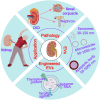Engineered Extracellular Vesicles in Chronic Kidney Diseases: A Comprehensive Review
- PMID: 38469058
- PMCID: PMC10926925
- DOI: 10.2147/IJN.S452393
Engineered Extracellular Vesicles in Chronic Kidney Diseases: A Comprehensive Review
Abstract
Chronic kidney diseases (CKD) present a formidable global health challenge, characterized by a deficiency of effective treatment options. Extracellular vesicles (EVs), recognized as multifunctional drug delivery systems in biomedicine, have gained accumulative interest. Specifically, engineered EVs have emerged as a promising therapeutic approach for targeted drug delivery, potentially addressing the complexities of CKD management. In this review, we systematically dissect EVs, elucidating their classification, biogenesis, composition, and cargo molecules. Furthermore, we explore techniques for EV engineering and strategies for their precise renal delivery, focusing on cargo loading and transportation, providing a comprehensive perspective. Moreover, this review also discusses and summarizes the diverse therapeutic applications of engineered EVs in CKD, emphasizing their anti-inflammatory, immunomodulatory, renoprotective, and tissue-regenerating effects. It critically evaluates the challenges and limitations in translating EV therapies from laboratory settings to clinical applications, while outlining future prospects and emerging trends.
Keywords: application; chronic kidney diseases; drug delivery systems; extracellular vesicles; nanomaterials.
© 2024 Xue and Mi.
Conflict of interest statement
The authors declare that they have no competing interests.
Figures






Similar articles
-
Engineering Extracellular Vesicles as Delivery Systems in Therapeutic Applications.Adv Sci (Weinh). 2023 Jun;10(17):e2300552. doi: 10.1002/advs.202300552. Epub 2023 Apr 20. Adv Sci (Weinh). 2023. PMID: 37080941 Free PMC article. Review.
-
Harnessing engineered extracellular vesicles for enhanced therapeutic efficacy: advancements in cancer immunotherapy.J Exp Clin Cancer Res. 2025 May 2;44(1):138. doi: 10.1186/s13046-025-03403-w. J Exp Clin Cancer Res. 2025. PMID: 40317075 Free PMC article. Review.
-
Targeted delivery of extracellular vesicles: the mechanisms, techniques and therapeutic applications.Mol Biomed. 2024 Nov 21;5(1):60. doi: 10.1186/s43556-024-00230-x. Mol Biomed. 2024. PMID: 39567444 Free PMC article. Review.
-
Engineered extracellular vesicles: A new approach for targeted therapy of tumors and overcoming drug resistance.Cancer Commun (Lond). 2024 Feb;44(2):205-225. doi: 10.1002/cac2.12518. Epub 2023 Dec 28. Cancer Commun (Lond). 2024. PMID: 38155418 Free PMC article. Review.
-
Targeting Inflammatory Vasculature by Extracellular Vesicles.AAPS J. 2018 Feb 26;20(2):37. doi: 10.1208/s12248-018-0200-2. AAPS J. 2018. PMID: 29484558 Free PMC article. Review.
Cited by
-
Emerging Biomimetic Drug Delivery Nanoparticles Inspired by Extracellular Vesicles.Wiley Interdiscip Rev Nanomed Nanobiotechnol. 2025 Jul-Aug;17(4):e70025. doi: 10.1002/wnan.70025. Wiley Interdiscip Rev Nanomed Nanobiotechnol. 2025. PMID: 40840553 Free PMC article. Review.
References
Publication types
MeSH terms
Substances
LinkOut - more resources
Full Text Sources
Medical

